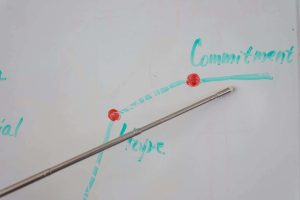As engagement in DEI work deepens, it becomes clear that well-intentioned pledges of commitment to incorporate core values of diversity, equity, and inclusion are not enough. Your team may be grappling with questions like, “How do we transform words on the page into reality?” or, “What are the actual actions we can take to realize our vision of a culture of diversity, equity, and inclusion?” and, “How can we prepare ourselves for the challenges that we will bump up against?” Your team may be thinking, “equity work is hard. So how do we stay motivated and engaged throughout the process?”
Although I don’t have all the answers, I can share what has worked in my experience. This is by no means an exhaustive list nor is it the only way to do this work. Just know that anything worthwhile requires a little bit of work. To quote Mahatma Gandhi, “The path is the journey,” and what we learn along the way as we encounter resistance, as we motivate ourselves, and as we engage others, offers great learning that supports personal and professional growth.

With that, here are three starting points for activating DEI in your organization:
1. Provide the tools
Offer folks training to increase their skills so they can hold conversations about DEI. Most people are yearning for and want to provide inclusion. Those in positions of power can invite traditionally excluded people to the table, but to sustain meaningful dialogue, everyone must have some skills to hold these important and often difficult conversations.
The foundation of this skill set is the ability to give and receive feedback. This skill can be actively honed and developed in three parts: A model to give feedback on how they are impacted by behaviors, the clarity to ask for the change in behavior they need to see, and the capacity to hear and receive feedback as a gift and not an indictment.
Conflict management is also a must-have skill. Organizations need to train people how to recognize, address (this is often during feedback conversations), and de-escalate the conflict.
The most important skill in this work is how to self-manage during these conversations. People need to know how to handle when they are:
- Triggered – when a word or action causes a strong reaction
- Flooded – when an overwhelming number of emotions all at once causes physical stress responses.
- Confronted – when someone is met with forms of hostility, microaggression, retaliation, and white fragility pushing back at them.
We are all responsible for defining the goals, doing the work required, and being part of the solution. Only with the skills outlined above (feedback, conflict management, and self-management) can we start putting DEI values into action.
2. Normalize Feedback
Use the technique of calling in and calling out. Calling in is bringing attention to behavior in a one-on-one setting to maintain the individual’s dignity while holding them accountable for the behavior. Calling out brings public attention to the behavior. While at times this is appropriate and needed, calling out can be difficult for the receiver because it can bring about shame. I have found that unless this is done with love and compassion it can be counterproductive.
The objective here is to pinpoint, through feedback, the impact of a certain behavior so that the person practicing that behavior is made aware of the consequences of their actions. The idea is not to shame or indict but rather to identify and bring awareness to the possible harmful impact of the behavior.
Building awareness is only one piece of calling in and calling out. In addition to bringing issues into the open, you need to build a mechanism in which there is a consistent opportunity for calling in/calling out behaviors:
Are there structural and procedural processes in place in which to have these feedback conversations?
- Is there a process where one can provide upward feedback?
- Is there a process to ensure everyone has access and opportunity for their voice to be heard?
- Are projects being designed in such a way that those who contribute to defining the issues are also responsible for the proposed solutions?
- Are the successes and failures distributed amongst all who contributed to defining the issue and solutions?
The inherent vulnerability required for this leads us to the topic of safety. Establishing psychological safety, which includes physical, emotional, and spiritual safety, is critical in moving this work forward.
You need to create gracious space where it is safe to learn in public. This means that you are ensuring that the people who are participating in DEI work practicing vulnerability, sharing their candid thoughts, making mistakes, or learning in public are not blamed when discomfort, disagreements, discouraging interactions, or decreases in productivity arise. There must be some safety for people to feel open to taking risks and potentially making mistakes in this work. It’s not what you did, it’s what you do next that is important.
We need to have the opportunity to learn together because we learn in relationship with each other. We need to meet people where they are and not “other” people. We are all on the same path as both learners and teachers.
It is important to recognize we are asking people to change behavior patterns and long-held beliefs. It is easier to shift behavior when the person who is making the change can feel that there is an honorable way to release those patterns. What are your organization’s procedures for deconstructing outdated processes and for identifying and eliminating processes that have translated to outgrown behaviors?
3. Evaluate and Reevaluate
As your team undergoes so much change, it’s important to hold regular reviews and a reevaluation of the values. You can use a variety of tools to do this:
- Inclusive leadership – ensuring all voices at all levels are invited and responsible for the outcome of the work.
- Collective leadership – ensuring the barriers are removed to include the skill development of others.
- Adaptive process – building a structure to continuously evaluate and make changes to your process to address newly identified issues.
The objective of these check-ins is to encourage questioning, disagreement, and collaboration in the spirit of collectively defining and maintaining success. One important thing to address is how to question without making others defensive. The method that best sustains communication in this space is two-sided. On one side, it’s critical to avoid questions with ambiguity and/or predetermined answers. Simultaneously, it’s important to listen without getting defensive so that what needs to emerge can be allowed to do so.
Using an adaptive process can provide the mindset and openness to allow the necessary conversations. This flexibility and balance can be tricky, and the dynamics of this dialogue will vary depending on the individuals within it. It’s important to carve time out to collectively set the intentions of the space so that all parties feel supported and able to engage.
Conclusion
Exhibiting diversity, equity, and inclusion values can be a complex and often meandering journey, with many entry points. That is what makes this work so meaningful and rewarding as results take shape. When you find yourself needing guidance, go back to the self-management, conflict management, and feedback tools mentioned above. If members of your organization can demonstrate these skills and the behaviors necessary to sustain progress, then you are on your way to living your DEI values.
About Alford Group

Alford Group is a national, full-service consultancy for nonprofits offering services in 6 focus areas. We are committed to a holistic approach that prioritizes the advancement of diversity, equity and inclusion in all facets of our work. Since our founding, we have partnered with over 3,000 nonprofits to accelerate their impact and advance social change.
About the Author

Anh Vo, Chief Culture Officer at Alford Group
Anh has worked extensively in advancing racial dialogues and the practice of justice, equity, diversity and inclusion in her work. She has encountered an expressed deep need from every level of the organizations she has partnered with for safety and belonging, where agreed sets of behaviors enable employees to work effectively in cross-cultural and multi-cultural environments.









